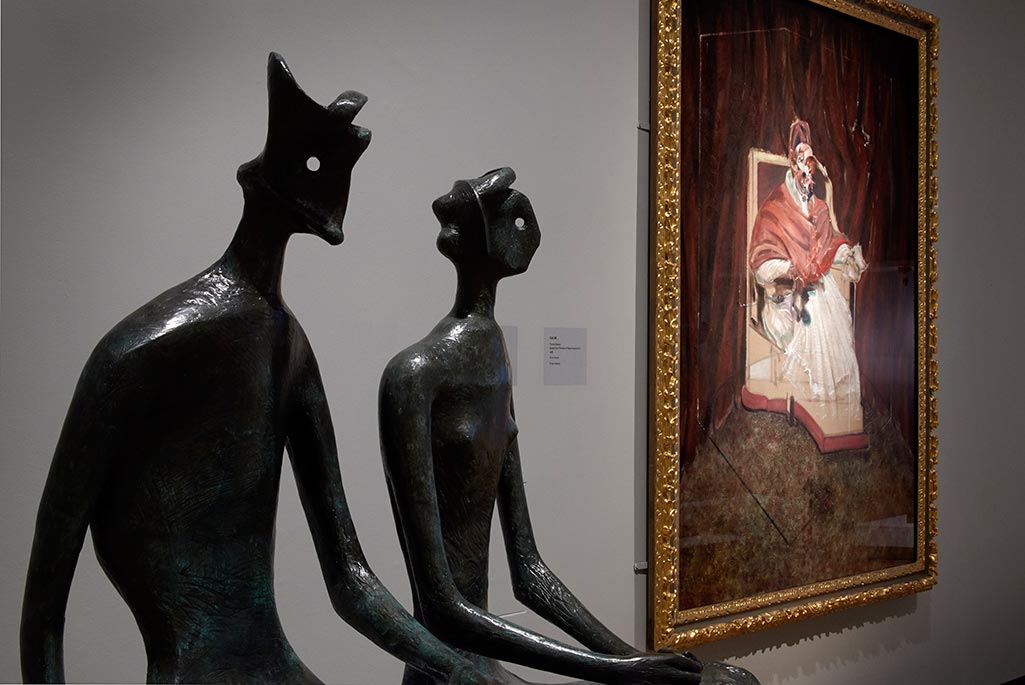One symptom of the rise of the curator as creator is that exhibitions are increasingly expected to justify themselves with arguments. Many recent shows have asked us to make comparisons between more or less successfully paired artists. In 2002 Matisse and Picasso squared up at Tate Modern; this year both Bacon and Moore have been exhibited alongside Rodin, in ‘Bacon and Rodin’ at Ordovas, London (8 February–6 April 2013) and ‘Moore Rodin’ at the Henry Moore Foundation, Perry Green (29 March–27 October 2013). It’s a comparative impulse which can be incredibly fertile, as in last year’s ‘Picasso and Modern British Art’ (Tate Britain, 15 February–15 July 2012) – heavy with both Moore and Bacon – where subtle stylistic genealogies emerged organically.
What you make of ‘Francis Bacon / Henry Moore: Flesh and Bone’ at the Ashmolean depends on whether you accept the curators’ argument, and whether you accept that curators should be making arguments. ‘At a certain level’, writes Richard Calvocoressi, ‘pairing these two giants of modern art may seem an unusual choice: the one a painter whose subject was flux, chance, the arbitrariness of existence; the other a sculptor who created universal symbols of strength and endurance’. The aim is to bring Bacon and Moore ‘together in a way which was perfectly understandable in the ‘60’s’, when they had several joint shows at Marlborough Fine Art.
Up to a point, the strategy works. Strip away the layers of accumulated critical sediment – Moore’s reputational decline after his death followed by his recent resurgence; Bacon’s steady ascent – and it’s clear that both shared formal if not moral concerns. They may have approached their subject, the human body after the traumas of the 20th century, from opposite angles, but there is plenty of common ground.
We’ve become used to Moore as the archetypal public artist – those monumental pieces plonked down across the land; all that do-goodery and those committee memberships – but it’s his quiet, smaller works that are revelatory here. Voyeuristic drawings of sleepers sheltering from the Blitz and miners taking a break are Blakean in their gentle attentiveness to the body at rest. Bacon was sceptical of these works, but in their peeping Tom observationalism they have something in common with his Painting (1950), with its Rothko flourishes, in which a body and its shadow are glimpsed between two solid dark bars, as though catching a glance of a bather through the crack of a door, and Man Kneeling in Grass (1952), a figure seen from behind stooping on a lawn, caught unawares.
‘Francis Bacon / Henry Moore: Flesh and Bone’, installation shot © Ashmolean Museum, University of Oxford

Then there are the compositional similarities. Moore once said that ‘a sculpture jumping off its pedestal is something I greatly dislike’, and much of Bacon’s work, despite its movement, aspires to a condition of sculptural monumentality. He once said that ‘the greatest images man has so far made have been in sculpture’, and Francis Warner, who knew both artists, recalls him tentatively asking whether Moore would give him lessons in sculpture. He never pursued the request, yet through thinking of his paintings ‘as sculptures’, he told David Sylvester in 1971, ‘it suddenly came to me how I could make them in paint, and do them much better in paint’.
Pitching an exhibition as a ‘conversation’ between artists is probably a good way of securing loans, but it inevitably risks becoming a competition, and the unavoidable truth here is that Bacon did do it much better in paint. Three Studies for Figures at the Base of a Crucifixion is the star, its pedestalled furies screaming across the room at Moore’s totemic Three Upright Motives (1955–56), which really want to be outside. Kneeling Figure (1982) is deeply sculptural – a body on a plinth, elevated from the ground on which it sits. Study from Portrait of Pope Innocent X knocks spots off Moore’s sedate King and Queen which stands next to it. An uneven match, then, but provoking for all that.
‘Francis Bacon / Henry Moore: Flesh and Bone’ is at the Ashmolean until 19 January 2014.



